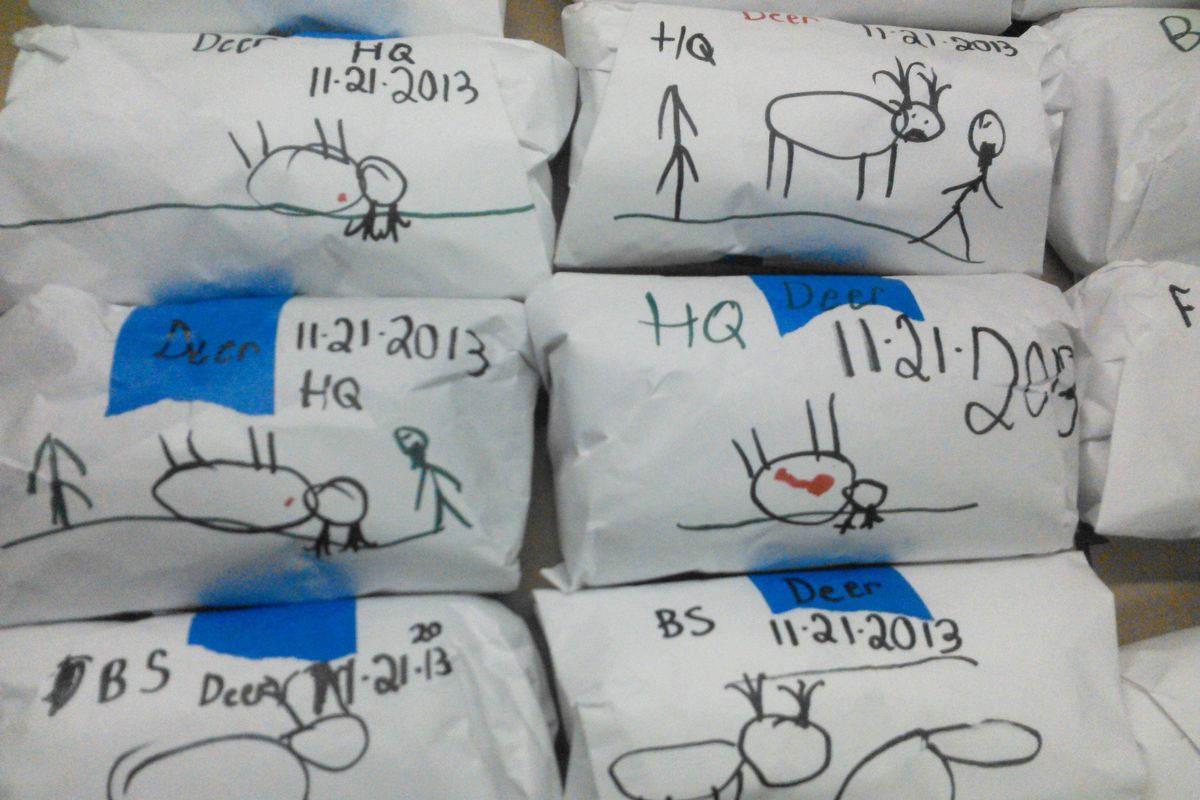Quality of game meat at dinner is measure of hunter’s prowess

A sportsman’s performance after the shot on a big-game animal — and the quality of meat he brings home — may say more about his hunting prowess than the size of the trophy.
Tommy Petrie, 43, is a lifelong hunter with a small mountain of racks, skins and sheds to his credit.
But if you went to his home in Pend Oreille County to hear a few hunting stories, he might not let you leave without opening the freezer. Inside are the neatly wrapped packages of home-butchered game meat decorated with animal art drawn by his two young daughters.
“This is a good way to get the family involved with the meat processing regardless of age,” he said. “Puts a smile on your face when you eat this meat.”
So does the flavor.
Game meat is precious, Petrie said, and he treats it that way from start to finish.
“I’ve seen some pretty poor examples of field care when I’ve volunteered at big-game check station’s,” he said. “In some cases, the hunters didn’t know any better. In others, the hunter was just overwhelmed by the chore.”
A consummate hunter in every category, he’s schooled on the 1,200 outdoor books in his home library and seasoned by stamping around his hunting grounds 12 months a year.
He was snowshoeing into the high country to document the first wolves moving in from Idaho long before it was official.
His record wreaks confidence, which explains why he hunts with a pack board on his back and, when he’s not hunting with his longbow, he often snaps a photo down the barrel of his muzzleloader or through the scope of his rifle before taking the shot.
“It’s all about the memories,” he said. “I cherish every hunt. I prefer going out with my longbow because that’s the most challenging. But if my job interferes with the archery season, I’m happy to go out with my muzzleloader or rifle.”
Petrie is a habitat specialist hired to help the Pend Oreille County PUD oversee wildlife components required in the federal relicensing of Box Canyon Dam.
“I get to monitor ospreys, eagles, frogs, salamanders and do other cool stuff,” he said. “I’m blessed to have this job.”
But during fall, free days are all about hunting.
“I plan each hunt with the intention of succeeding,” he said. “Of course, I don’t get something every time out, but that’s the mindset you need. You may push yourself to the ragged edge just to get the elk.
“Every hunter should ask himself how he’s going to get the meat up a thousand feet of elevation out of a hole.
“You know who your friends are when they’re willing to answer your telephone call when they know you’re hunting elk or moose.”
Having companions on call, a game cart and his packboard are all part of the plan, but Petrie recalls one hunt in the Salmo-Priest Wilderness that dictated some heavy-duty solo work. He humped out 177 pounds of gear, boned-out meat and a mule-deer head for eight hours and nearly two miles uphill to get the job done.
“I’m getting to the age where I realize that sort of load won’t always be an option,” he said.
The skull and antler mount of that buck hangs prominently at his home.
“But the trophy shot for me is photo of all the meat laid out in the shop on a tarp,” he said. “Clean, beautiful meat with virtually no waste. It’s a beautiful thing.”
Backcountry hunting in warm weather poses a double-whammy of challenges that increase with size of animal.
Cooling the meat is the first consideration. Smaller elk can be quartered and packed out quickly and cool as well as a block of boned-out meat, he said.
“But bigger animals will bone-sour,” he said. “Every situation is different. Usually, I gut the animal because it’s a quick way to get rid of some heat at the entrails can be dragged to lure the bugs away.
“Sometimes I’ll just dive right into skinning and boning.”
First, he takes time to set up for keeping the meat clean.
“It’s an attitude you have to get into from the beginning,” he said.
Petrie likes to peel the skin as he goes and use it like a tarp to help keep the meat clean as he cuts it away from the bone. He also carries a light 8-by-10 foot plastic drop cloth.
“I always carry a small saw, but you can do all the work with a knife. I’ve come to prefer knives with replaceable blades for quickness. It’s a huge advantage to work with a sharp blade from beginning to end.”
Ultralight synthetic meat sacks by Caribou Gear are Petrie’s choice for protecting the meat from flies and packing it out.
“Sometimes it’s a war with flies trying to bomb your meat with eggs,” he said. “You have to be ready for it.”
Hang meat or quarters or put it on downfall off the ground in the shade as you work, he said. Temperatures can be significantly cooler near a creek.
“I always carry parachute cord and what I’ll need to stay out through the night,” he said.
“The main thing is to think ahead to avoid having one of the greatest experiences of your life turn into a nightmare because you ruined the meat or worse.”